See the
photographs of the Saxmundham to Aldeburgh branch line
stations.
Leiston is a unique town among the wide variety of villages and settlements in Suffolk. In early history, Leiston was known only for its proximity to the river Mismer and important ports at Syzewell and Minsmere Havens (and therefore lucrative wrecking and smuggling activity) and the presence of nearby Leiston Abbey which would have dominated the local economy until the dissolution of the monasteries under Henry VIII. By fluke of history, the business of one bladesmith, Richard Garrett (born 12.10.1757), grew steadily from 1778 to metamorphose into an important Victorian engineering factory. Famous for its threshing machines, traction engines and many other products, Garretts engineering works transformed Leiston from a village of a few hundred inhabitants into an industrial town. See below for The Long Shop.
Corn mill
Many other businesses were drawn into Leiston to service the growing population including that of corn miller. In 1865, we find the first mention of a smock mill run by James Bedwell operating on a ridge carrying the railway line from the station over Valley Road and towards Thorpe Halt and Aldeburgh. Henry James Lambert is first mentioned as operating the windmill in 1892, alongside a steam driven mill. The slope from Valley Road up to the site is still known as Lambert's Lane and the cottage on the corner carries the familar cartouche of cream-white paint with the decorative serif lettering (note the inward-sloping 'H'): 'MILL HOUSE'.
Leiston is a unique town among the wide variety of villages and settlements in Suffolk. In early history, Leiston was known only for its proximity to the river Mismer and important ports at Syzewell and Minsmere Havens (and therefore lucrative wrecking and smuggling activity) and the presence of nearby Leiston Abbey which would have dominated the local economy until the dissolution of the monasteries under Henry VIII. By fluke of history, the business of one bladesmith, Richard Garrett (born 12.10.1757), grew steadily from 1778 to metamorphose into an important Victorian engineering factory. Famous for its threshing machines, traction engines and many other products, Garretts engineering works transformed Leiston from a village of a few hundred inhabitants into an industrial town. See below for The Long Shop.
Corn mill
Many other businesses were drawn into Leiston to service the growing population including that of corn miller. In 1865, we find the first mention of a smock mill run by James Bedwell operating on a ridge carrying the railway line from the station over Valley Road and towards Thorpe Halt and Aldeburgh. Henry James Lambert is first mentioned as operating the windmill in 1892, alongside a steam driven mill. The slope from Valley Road up to the site is still known as Lambert's Lane and the cottage on the corner carries the familar cartouche of cream-white paint with the decorative serif lettering (note the inward-sloping 'H'): 'MILL HOUSE'.
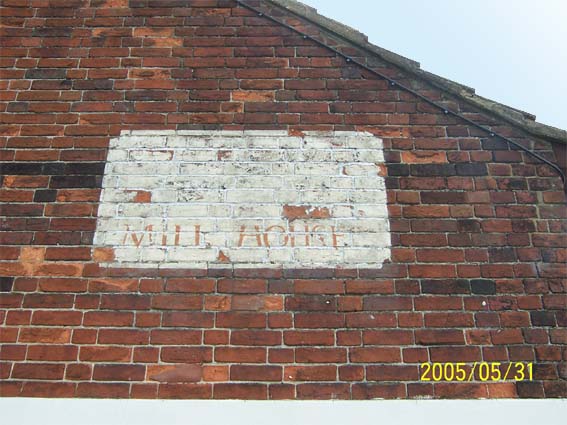
But surely there must
have
been something,
perhaps an arrow, above the name? The mill was dismantled in 1917 when
the use of wind power to grind corn became uneconomical, however some
of the original buildings still exist at the top of Lamberts
Lane. Demolition was carried out by John 'Tiny' Brown who also
demolished the mill at Snape, the base of which was later used as a
house by the Suffolk composer Benjamin Britten. The mill stones from
Snape were used in the refurbishment of Saxtead mill, just outside
Framlingham.
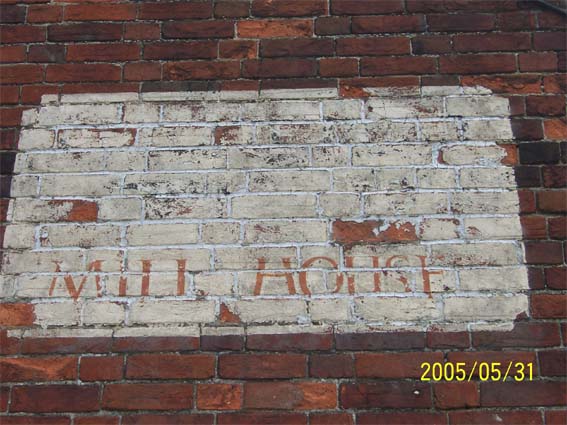
[UPDATE: 16.6.2014: "I have just
chanced upon your photo of the old sign in Leiston (usually now called
a "ghost sign") which refers to Mill House. My
old school teacher, a Miss Reilly, lived there in the 60s (and probably
had for years before that) when I was at junior school until her death
(I think) in the 80s.
You ask if there was an arrow above the words "MILL HOUSE". The sign actually said "To Mill House" and above that there was a hand pointing to the left. It looked a lot like the "Go to Jail" hand pointing on the Monopoly board. Shame that has disappeared but pleased to see the sign itself has at least survived in part.
Hope this is of interest to you and your community. Thanks for the photos! Best regards, Melanie Emmerson." Thanks to Melanie for the additional information.]
You ask if there was an arrow above the words "MILL HOUSE". The sign actually said "To Mill House" and above that there was a hand pointing to the left. It looked a lot like the "Go to Jail" hand pointing on the Monopoly board. Shame that has disappeared but pleased to see the sign itself has at least survived in part.
Hope this is of interest to you and your community. Thanks for the photos! Best regards, Melanie Emmerson." Thanks to Melanie for the additional information.]
Church of St Margaret of Antioch
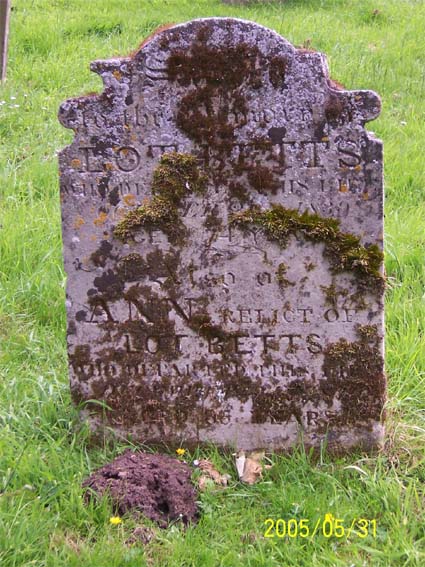
This is a gravestone
close
to the main
door of Leiston church in Waterloo Avenue. An earlier photograph of the
same stone from the 1970s formed the basis of a recently rediscovered oil painting by
Borin Van Loon. We think it must have been the name of
the grave's occupant which caught the eye in the early 1970s:
'Sacred
to the memory of
LOT BETTS
WHO DEPARTED THIS LIFE
Third February 1873
Aged 74 years
Also of
ANN RELICT OF
LOT BETTS
WHO DEPARTED THIS LIFE
...
AGED 86 YEARS'
Hopefully Ann was not known in her lifetime as "Lot's
wife. This 2005 view
is replete with molehill, dead leaves and a wealth of algae and moss to
obscure the ancient carved script. The nearby church is one of the most
distinctive, not to say eccentric, ecclesiastical buildings in a county
groaning with hundreds of historic churches and monastic ruins.to the memory of
LOT BETTS
WHO DEPARTED THIS LIFE
Third February 1873
Aged 74 years
Also of
ANN RELICT OF
LOT BETTS
WHO DEPARTED THIS LIFE
...
AGED 86 YEARS'
Leiston Church is
dedicated, along with
nineteen others in the county, to St Margaret of Antioch. She is said
to have been the Christian daughter of a pagan priest, Aesidius of
Antioch, during the reign of the Roman Emperor Diocletian. She was
denounced as a Christian by the prefect Olbrius after she rejected his
suit and was subjected to a number of hideous ordeals including being
swallowed by Satan in the form of a dragon. According to legend, the
dragon's belly burst open and she emerged unharmed. She killed the
dragon (surprisingly still alive!) with a cross-tipped spear
symbolizing the triumph of good over evil. She is the patron saint of
women in childbirth and her emblem is a dragon. The church itself was
probably built on the site of an earlier Saxon church, one of three
known to have been in the area. A major rebuild, apart from the 14th
century tower, in 1854 by maverick Gothic Revival architect Edward
Buckton Lamb reshaped the interior of the church as a large auditorium
for the evangelical preachings of the current incumbent John Blathwayt.
Imaginitive use of Kentish rag stone, flint and French Caen stone for
detailing gives the exterior a period appearance, but the interior is a
riot of timber roofing beams and carving with some attractive painted
surfaces in the chancel.
Leiston Works
No mention of Leiston's history is worth it's name if Garrett's is not included. Once the dominant employer in the area, Garrett's engineering works once occupied two large sites and was to Leiston what Ransome's was to Ipswich: big, wealthy, stinky, filthy and hard for the workers. Garretts was a family business from 1778 to 1932, after which the company passed into the hands of Beyer Peacock. The works finally closed in 1981. However, the historic core was preserved and opened as a museum in 1984.
Leiston Works
No mention of Leiston's history is worth it's name if Garrett's is not included. Once the dominant employer in the area, Garrett's engineering works once occupied two large sites and was to Leiston what Ransome's was to Ipswich: big, wealthy, stinky, filthy and hard for the workers. Garretts was a family business from 1778 to 1932, after which the company passed into the hands of Beyer Peacock. The works finally closed in 1981. However, the historic core was preserved and opened as a museum in 1984.
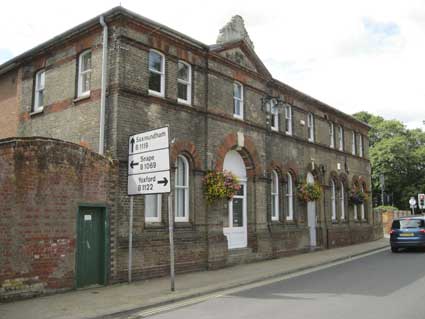 2013
images
2013
imagesNow residential, the Works Hall still stands and is (just about) named in screw-on lettering in the central triangle:
'1862
WORKS HALL'
WORKS HALL'
In the upper stone shield with
lion rampant is a scroll bearing the words:
'A DEO OMNIA'
which is Latin for 'From God in
all things'.
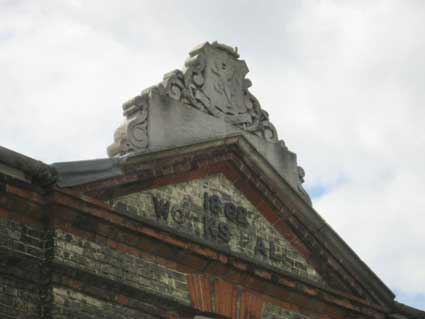
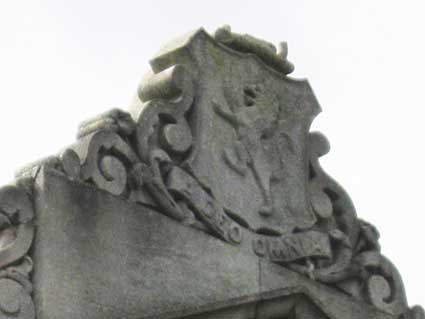
The Engineers Arms
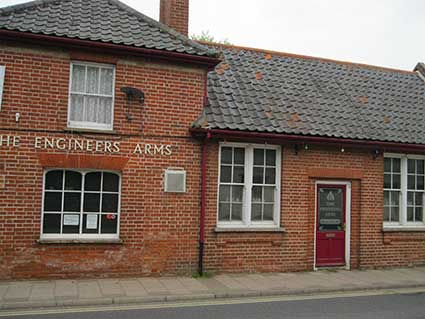
A glance across the road in summer 2013 showed that the once excellent The Engineers Arms was no longer open for business:

The 'frosting' on the glazed doors are almost certainly vinyls reading:
'THE
ENGINEERS
ARMS
Adnams Fine Ales'
ENGINEERS
ARMS
Adnams Fine Ales'
with the Adnams of Southwold
emblem above. The door on the right bears the brass plate: 'LOUNGE
BAR'.
A sad sight at a period when so many public houses are closing
throughout the country.

Two of the windows on this street have leaded light lettering:

The Long Shop Museum
The Long Shop is the name given to the oldest part of Garrett's historic engineering site with its collection of buildings full of exhibits and information. The door below at one end of the actual Long Shop building bears a cast iron lintel with the (slightly wonky) date: '1852'. The Long Shop, built in 1852-53, is a very early example of a building designed for assembly-line production. Given the importance of water in foundry-work, the works has the deepest well in Suffolk along with a large, restored, Grade II-listed water tower.

Two of the windows on this street have leaded light lettering:
'PUBLIC BAR'

The Long Shop Museum
The Long Shop is the name given to the oldest part of Garrett's historic engineering site with its collection of buildings full of exhibits and information. The door below at one end of the actual Long Shop building bears a cast iron lintel with the (slightly wonky) date: '1852'. The Long Shop, built in 1852-53, is a very early example of a building designed for assembly-line production. Given the importance of water in foundry-work, the works has the deepest well in Suffolk along with a large, restored, Grade II-listed water tower.
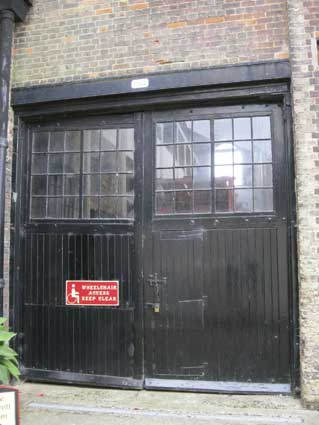

Outside behind chairs and tables on a terrace is a large cast beam bearing the notice:
'BRIDGE BEAM
RECOVERED FROM EASTBRIDGE, NEAR LEISTON
PRESENTED BY A.J. MEW (SAXMUNDHAM)
METAL MERCHANTS
17th SEPTEMBER 1987'
1848
LEISTON WORKS'
RECOVERED FROM EASTBRIDGE, NEAR LEISTON
PRESENTED BY A.J. MEW (SAXMUNDHAM)
METAL MERCHANTS
17th SEPTEMBER 1987'
The beam itself in restored
condition has three cartouches carrying the legend:
'R. GARRETT & SON1848
LEISTON WORKS'
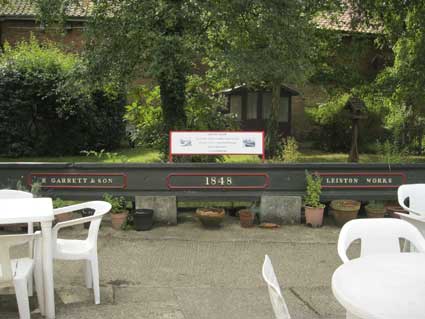
The museum has several of Garrett's steam engines, including Consuelo Allen, a road roller rescued from Spain, a very rare Suffolk Punch steam tractor and the rescued and restored Sirapite, the works' shunting engine. As well as steam engines, the works was famous for agricultural implements, and many are on display, including a threshing machine. There's also a living wagon, one of the wonderful caravans used as accommodation by the drivers of the engines when on the road. Much recommended.
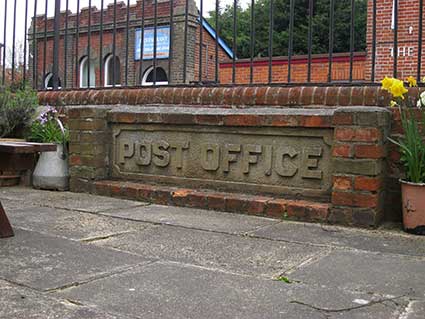
Above: another exhibit built into the perimeter wall is a carved stone cartouche: 'POST OFFICE', presumably rescued form an earlier post office building in Leiston during its demolition.
Council Offices and Library

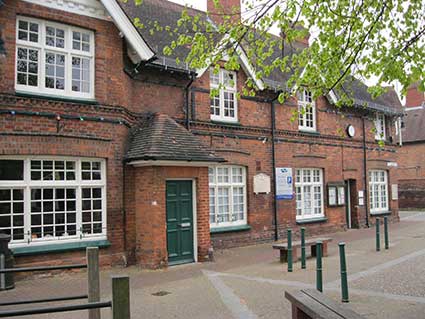 2015 images
2015 imagesSet back from Main Street are the public library and Leiston Town Council offices. The civic nature of the building is denoted by the typical castiron 'PUBLIC CONVENIENCES' sign, replete with arrow. This probably dates from the early 20th century and it would be nice to think that it was cast in the Garrett's foundry across the road.


The building bears two war memorials. The first is a carved stone plaque bearing the inscription:
'1914
1918
1939 – 1945
IN MEMORY OF THOSE
WHO LOST THEIR LIVES
IN THE TWO WORLD WARS
ERECTED BY THE LEISTON BRANCH
OF THE BRITISH LEGION'
1939 – 1945
IN MEMORY OF THOSE
WHO LOST THEIR LIVES
IN THE TWO WORLD WARS
ERECTED BY THE LEISTON BRANCH
OF THE BRITISH LEGION'
Larger memorials with lists of
the names of the dead are sited in the churchyard of St Margaret of
Antioch (with a crucifix figure in bronze by Dorothy Anne Aldrich Rope
– neice of the noted Suffolk sculptor Ellen Mary Rope –
shown below) and in Leiston cemetery.
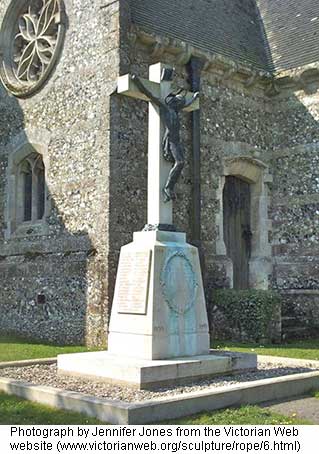
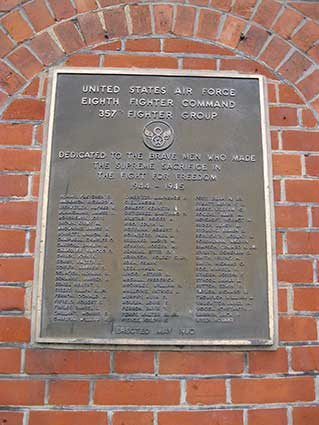


Above right: the metal plaque on the council offices commemorating:
'UNITED
STATES AIR FORCE
EIGHTH FIGHTER COMMAND
357TH FIGHTER COMMAND
DEDICATED TO THE BRAVE MEN WHO MADE
THE SUPREME SACRIFICE IN
THE FIGHT FOR FREEDOM
1944–1945'
followed by a long list of names and 'ERECTED MAY
1980'. Many will remember the presence of USAF staff in this area of
Suffolk, concentrated around the air bases at Bentwaters, near
Rendlesham and Woodbridge, near Sutton'. The American accents and
overhead jet aircraft were commonplace after the Second World War,
through the years of the Cold War and until the troops, their families
and belongings were shipped back to the USA in huge transporter
aircraft in 1992.EIGHTH FIGHTER COMMAND
357TH FIGHTER COMMAND
DEDICATED TO THE BRAVE MEN WHO MADE
THE SUPREME SACRIFICE IN
THE FIGHT FOR FREEDOM
1944–1945'
Ashford Jeweller, 58 High Street
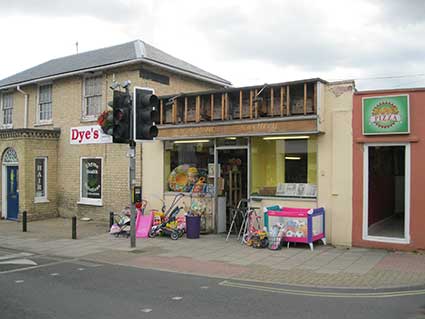 2016 images
2016 imagesIn the summer of 2016 the small shop near the corner of the Cross Street, Sixewell Road, High Street crossroads had its name board removed to reveal a previous occupant:
'R.S. Ashford.
Jewellery.'
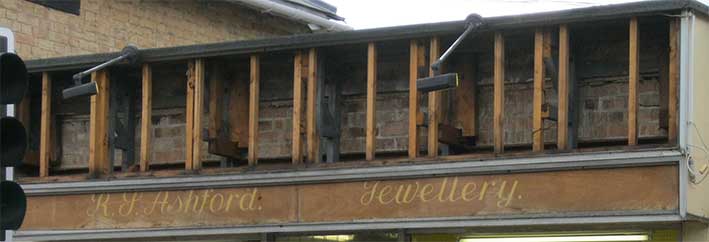
Paradise


Although listed as 'Paradise Place' on some maps, the street nameplate – an attractive, cast iron, cartouche design (perhaps made in Leiston Works?) – is unequivocal. Paradise is defined as 'a place of timeless harmony', but quite why it is applied to street names is unclear. There is a Paradise Street, home of Birmingham Town Hall, in Birmingham. The same name can be found in Richmond, Southwark (both London), Bristol, Liverpool, Oxford, Cambridge and Sheffield. Paradise Lane can be found in Clitheroe; Paradise Parade is in Kings Lynn and there are doubtless further examples. Perhaps it is the age-old reason that Paradise is a pleasant word for a thoroughfare.
Eastward Ho

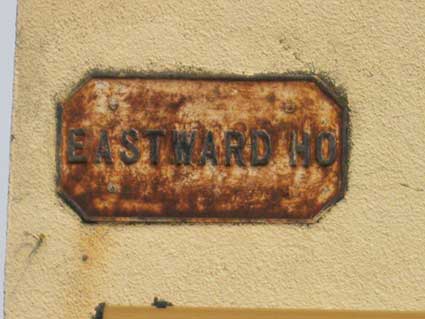
In the above photograph Sizewell Road runs off at the left towards the sea with Eastward Ho! (we like to see it written with an exclamation mark) marked by a modern street nameplate at pavement level and a much older cast nameplate high on the wall – rendered and painted around and bearing the patina of age. Its equivalent road is 'WESTWARD HO' which doesn't, sadly, have such a period sign. Westward Ho is notable for two reasons. Firstly, it runs away from the level crossing and Leiston Station (seen on our Saxmundham to Aldeburgh branch line page), parallel with the railway for a while. Secondly, it is the road serving Summerhill, A.S. Neil's pioneering school. In Leiston, he created a community in which children could be free from adult authority. Controversial at times, but recognised as an important contribution to educational thinking: 'Founded in 1921 and still ahead of its time'.
 The
only street nameplate for Westward Ho
The
only street nameplate for Westward HoReading
May, D.Y. and K.: 'From flint knappers to atom splitters: a history of Leiston-cum-Sizewell'. Quickthorn Books, 2001.
Whitehead, R.A.: 'Garretts of Leiston'. Model and Allied Publications, 1964.
Aldringham Chapel
Leiston is closely linked with the village of Aldringham; whence workers at the Garrett Engineering Works walked across the fields to and from work.
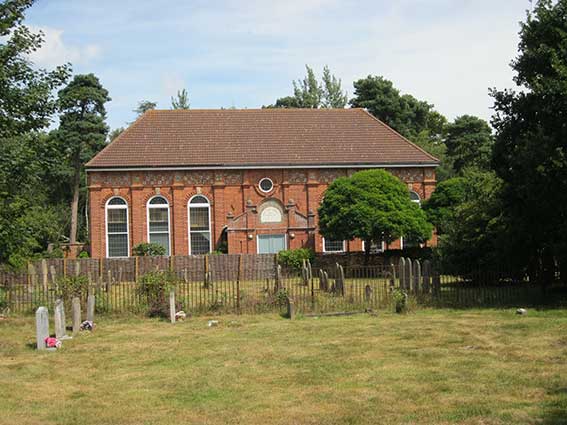 2017
images
2017
images
This is a good place to include the former Providence Chapel on Aldringham Common. The Thorpeness & Aldringham Heritage Group tells us that this is the work of local architect, artist and poet, Cecil Howard Lay FRIBA (1885-1956):-
'Another one of Lay's architectural surprises is the seven-bay, brick, nominally Neo-Georgian, former Providence Baptist Chapel (now a private house) on the common to the north of the B1353. It has three tall round-arched windows to either side of a three-bay porch and the seven bays are separated by giant pilasters whose capitals and the frieze between them is chequers of brick and stone. I will not forget my amazement at encountering this classical, essentially urban edifice emerging from the heathland as I walked over the common towards The Follies.
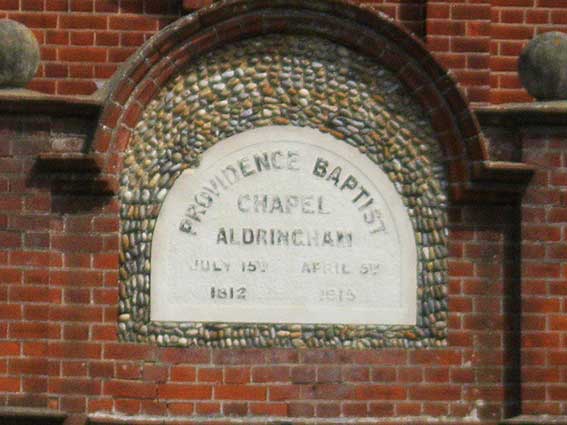
The old chapel was illuminated by a chandelier of oil lamps hanging from the centre and smaller oil lamps hung on the walls. Outside the chapel was an enclosed burial ground, a thatched-roofed stable on the east side and a well on the west side. Despite the chapel's isolated position, it was within view of Stone House, a gentleman's residence to the rear (north) who owned the land bordering the chapel. He was so annoyed at the prospect of a Conventicle barely visible from his drawing room that he planted a screen of fir trees to hide the chapel from view. Additions to the old chapel were made over the years and it was reconstructed in 1856, but by 1914 it was considered unsafe and demolished. Lay's chapel was erected on the same site, but with the pulpit on the east side instead of the north side as in the old chapel. Fundraising over the previous eleven years resulted in a tender of £1,228 5s 6d from Mr. G A Smyth, a Leiston builder, being accepted in March 1914. A large congregation of Strict Baptists assembled on April 5th 1915 for the opening of the new chapel, which was named 'Providence' as an outer token of the Providential care and guidance that had led the worshippers to that day.'
Home
Return to Historic Lettering from outside Ipswich
Please email any comments and contributions by clicking here.
Search Ipswich Historic Lettering
©2004 Copyright throughout the Ipswich Historic Lettering website: Borin Van Loon
No reproduction of text or images without express written permission
May, D.Y. and K.: 'From flint knappers to atom splitters: a history of Leiston-cum-Sizewell'. Quickthorn Books, 2001.
Whitehead, R.A.: 'Garretts of Leiston'. Model and Allied Publications, 1964.
Aldringham Chapel
Leiston is closely linked with the village of Aldringham; whence workers at the Garrett Engineering Works walked across the fields to and from work.
 2017
images
2017
imagesThis is a good place to include the former Providence Chapel on Aldringham Common. The Thorpeness & Aldringham Heritage Group tells us that this is the work of local architect, artist and poet, Cecil Howard Lay FRIBA (1885-1956):-
'Another one of Lay's architectural surprises is the seven-bay, brick, nominally Neo-Georgian, former Providence Baptist Chapel (now a private house) on the common to the north of the B1353. It has three tall round-arched windows to either side of a three-bay porch and the seven bays are separated by giant pilasters whose capitals and the frieze between them is chequers of brick and stone. I will not forget my amazement at encountering this classical, essentially urban edifice emerging from the heathland as I walked over the common towards The Follies.

'PROVIDENCE BAPTIST
CHAPEL
ALDRINGHAM
JULY 15TH, 1812 APRIL 5TH, 1915'
The existing chapel, which was erected in 1914-15, replaced a
much plainer building of 1812. The old chapel was far more
restrained and traditional in design, with two front entrances leading
into small vestibules giving access into the chapel and galleries by
separate doors. The sittings were within high box pews and across the
front of the chapel on either side of the pulpit were rows of two-seat
pews; the one nearest to the pulpit being reserved for the appointed
Deacon who announced the hymns. The galleries were on both sides
and at the rear, one side being reserved for the Sunday School
scholars. The seating capacity was about 800, which was well
occupied during the 19th century but was totally inadequate for special
occasions such as the Sunday School Anniversaries.CHAPEL
ALDRINGHAM
JULY 15TH, 1812 APRIL 5TH, 1915'
The old chapel was illuminated by a chandelier of oil lamps hanging from the centre and smaller oil lamps hung on the walls. Outside the chapel was an enclosed burial ground, a thatched-roofed stable on the east side and a well on the west side. Despite the chapel's isolated position, it was within view of Stone House, a gentleman's residence to the rear (north) who owned the land bordering the chapel. He was so annoyed at the prospect of a Conventicle barely visible from his drawing room that he planted a screen of fir trees to hide the chapel from view. Additions to the old chapel were made over the years and it was reconstructed in 1856, but by 1914 it was considered unsafe and demolished. Lay's chapel was erected on the same site, but with the pulpit on the east side instead of the north side as in the old chapel. Fundraising over the previous eleven years resulted in a tender of £1,228 5s 6d from Mr. G A Smyth, a Leiston builder, being accepted in March 1914. A large congregation of Strict Baptists assembled on April 5th 1915 for the opening of the new chapel, which was named 'Providence' as an outer token of the Providential care and guidance that had led the worshippers to that day.'
Return to Historic Lettering from outside Ipswich
Please email any comments and contributions by clicking here.
Search Ipswich Historic Lettering
©2004 Copyright throughout the Ipswich Historic Lettering website: Borin Van Loon
No reproduction of text or images without express written permission